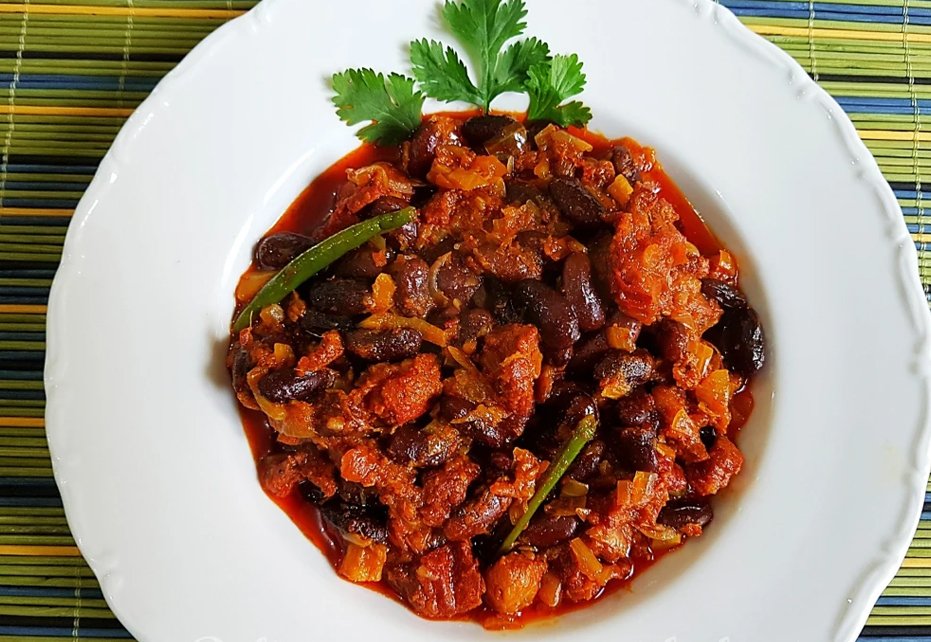
Vegan Goan Feijoada
Vegan Goan Feijoada Recipe
This vegan Goan Feijoada is a creamy stew of pinto beans and vegan sausage in a deliciously spiced coconut-tamarind sauce. It is easy to make, one-pot, and it’s soy-free and gluten-free, making it comfort food for everyone.
In the United States, feijoada (pronounced fay-jo-aa-duh) is better known as a Brazilian black bean stew with pork and/or beef: a dish so beloved, it has been anointed Brazil’s national dish. But the feijoada I knew growing up in India was the Goan version, usually made with pink beans or red kidney beans and Goan sausages, which are infused with cinnamon, paprika, ginger and garlic.
It was differently delicious, and incredibly so.
Feijoada is named for “feijão” or “beans,” in Portuguese, and there are versions of this dish to be found in many former Portuguese colonies, from Goa to Mozambique to Macau. There is also, of course, a Portuguese feijoada that inspired these other versions (read through the comments for a fantastic recipe posted by Daisy, a reader from Portugal, when I first shared this Goan Feijoada recipe many years ago).
The food of former colonies like Goa offers an interesting study in how occupiers cross-pollinated culinary traditions and ingredients across the distant lands they controlled. Those influences were readily embraced by locals and they persisted long after the occupiers left, as opposed to other colonial legacies that are unwelcome and are deliberately–and understandably–erased or lost over time.
The names of cities, for instance, are easily changed back to what they used to be, and political forces even attempt to rewrite history books to put a spin on events. But connections forged through food linger and are embedded unshakably within cultures, impossible to erase. In fact, who would want to?
In Goa, local Christian converts made feijoada by marrying pink beans or red kidney beans (also brought into India by the Portuguese from south and central America) and the meat with local spices and coconut, a fruit that grows abundantly in this coastal state. My Goan stepmother, who was a talented and adventurous cook, would make an accidentally vegan version of Feijoada. My version, which does use meatless sausages, is inspired by hers, and it is mind-blowingly delicious — and quite unique.
Why you’ll love this Goan feijoada
- It’s delicious. Imagine all those lovely textures of the beans and the sausage in that flavorful, spiced coconut sauce.
- It’s unique. This is not a dish you’ll easily find on an Indian restaurant menu, but making it at home is not at all difficult.
- It’s hearty. The beans and sausage in this recipe make for a very filling meal.
- It’s everyone-friendly: This feijoada is free of gluten and soy and it will appeal to everyone you are feeding, vegan to omnivore and kid to adult.
- It’s healthy. You know beans are great for you. The sausage, which you can leave out, adds more protein to this dish, and the spices are, of course, great for you.
Ingredients
- Pinto beans (or red kidney beans. You can use either canned beans or cook them from scratch. If using canned beans, drain out the liquid. If you cook your own beans, strain the beans but reserve the cooking stock.)
- Vegan sausage links. I used Beyond sausages, which are soy-free and gluten-free. You can use any kind)
- Vegetable oil. Any flavorless oil works. You can also use coconut oil.
- Onion. For sweetness and spice.
- Garlic. Because it’s garlic, and you need its deliciousness here.
- Dry red chili peppers. Or use red pepper flakes if that’s what you have.
- Cloves. Cloves are extremely aromatic and slightly sweet, and they add great depth of flavor here.
- Black peppercorns. These add heat alongside the red chili peppers, but it’s a more complex, flavorful, layered heat.
- Coriander seeds. The lemony flavor of coriander seeds is perfect in most Indian stews and curries, and it is especially welcome here.
- Cumin seeds. For earthy, smoky, bold flavor.
- Tamarind paste. The tamarind adds tang and depth–something vinegar doesn’t do, but you can switch out the tamarind with white or apple cider vinegar with good results. Vinegar is often used in
- Coconut milk. In Goa you’d add grated coconut to this dish, but I really like coconut milk and the smoothness it brings to this recipe. You can use grated coconut if you’d rather. Just add it to the blender with the other ingredients instead of the coconut milk and be sure to use more water to help blend the ingredients.
- Salt to taste
- Cilantro. For a fresh, lemony finish.
Nutrition
Calories: 244kcal | Carbohydrates: 13g | Protein: 11g | Fat: 17g | Saturated Fat: 12g | Polyunsaturated Fat: 1g | Monounsaturated Fat: 1g | Potassium: 372mg | Fiber: 4g | Sugar: 2g | Vitamin A: 13IU | Vitamin C: 6mg | Calcium: 34mg | Iron: 2mg

